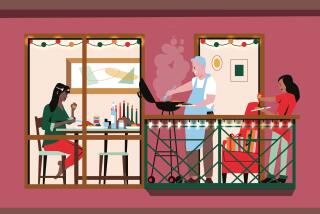What the heck is that? An heirloom
There it is, way at the back of the cupboard. What is that thing? We see it only when weâre hauling out all the special-occasion tableware for the holidays.
Weâve already got the carving set out, and the gravy boat and ladle. The sugar tongs, olive forks and butter picks are scattered around us. Along with that dish over there, which is for cranberry jelly -- or anyway, we think it is.
But then thereâs that thing in the back, that big shallow spoon with scary-looking tines writhing out of one edge. Itâs been in the family forever and nobody knows exactly what itâs for.
Such strange items are cherished heirlooms now, but even if we donât know their functions -- and plenty of times, the experts canât figure them out either -- they arenât just oddities from the past. Theyâre perfectly adapted to specific uses, certainly better than the utensils we improvise with today. In their time, they were totally practical.
Most date from one 70-year period, the golden era of formal dining, when swell hosts couldnât wait to show off exotic foods like, oh, celery or asparagus, and felt the need for special equipment to do so. Starting in the 1850s, silver and china firms in the United States and Europe catered to a craze for highly specialized tableware. By 1900, 140 kinds of utensils might be available in a given silver pattern -- 140 kinds of knives, forks, spoons, tongs and spatulas of various sizes and shapes, plus nut picks, lobster claw crackers and other oddments. And that doesnât count the dishware that went with them.
âIt had a lot to do with marketing,â observes Jessica Smith, curator of American art at the Huntington Library, Art Collections and Botanical Gardens in San Marino. But the demand was genuine.
And these things are undeniably cool to have. As Smith says, âOne of [railroad heiress] Arabella Huntingtonâs favorite things to give was a tea set designed by Tiffany. I wouldnât have minded being a guest at a wedding where she was giving those away.â
Once upon a time, celery was a luxury because, like endive, it had to be mounded with dirt as it grew to keep it from being bitter. So, a utensil called a celery vase was invented for displaying a head of celery at the table as if it were a bouquet of flowers. Diners would pluck off stalks one at a time and dip them in a salt container at the base of the vase, congratulating themselves on living pretty high.
Asparagus spears were awkward to handle, so people used a specialized implement to serve them, either an oversized serving fork with four or five tines, a broad spatula with a âhoodâ to keep the spears from rolling off or a set of tongs with grippers a couple of inches wide.
When it came to eating the asparagus, 19th century people preferred to eat a stalk from one end to the other, like a banana. Etiquette permitted you to pick it up with your fingers, but for the fastidious there were individual asparagus tongs for picking up a single spear by the base.
As one of the first canned foods, sardines had their moment of fashionability. They were also fragile, so they needed a special extra-wide serving fork -- it looked like a miniature leaf rake -- to pick them up securely, or even sardine tongs designed like a hinged pair of leaf rakes.
We still use forks with very small, slightly curved tines for winkling oysters out of their shells, but these days, we rarely serve the oysters on special plates with oyster-shaped depressions in them. Peas had their own server, a sort of miniature strainer called a pea spoon. Potato chips were once upscale enough to deserve their own serving utensil, a flattish scoop called a Saratoga chip server.
In the 19th century, people liked to poach eggs at the table, probably for the same reason we enjoy fondues and Mongolian hotpots today. The eggs were poached in tin containers filled with boiling water. Cookbooks warned that one should replace the water with fresh boiling water halfway through the process so the eggs could cook thoroughly.
Some utensils were a response to necessity. A peculiar sort of bowl, often shaped like a nautilus shell, was called a spoon warmer. Before central heating, houses were much colder in winter than they are today, so the warmer would be filled with boiling water and the serving spoons kept in it so they wouldnât chill the food when it was served.
Tea was once so expensive that it was stored in a lockable container called a tea caddy. For reasons of space, the spoons in a caddy had peculiarly short handles, and that became the tradition. People continued to use short-handled âcaddy spoonsâ for tea leaves even after prices came down.
What inspired most of the specialized tableware was simply the 19th century formal dinner itself. It was a series of obligatory courses: shellfish, soup, appetizer, fish, roast, lighter meat dish, vegetable, wild game, pastry or pudding, ice cream and finally coffee, often with a sorbet in the middle of the meal and a cheese course toward the end.
Even today, when a dinner party may feature no more than three courses, we donât like to ask our guests to lick their spoons and forks clean and hold on to them for the next course. In the Victorian age, when people made a stricter distinction between formal and informal occasions than we do, it would have been unthinkable.
As a result, anybody who hoped to entertain in a respectable manner had to have a whole set of tableware for every course. So, they figured, why not have them specifically designed for each kind of food? Why not have bonbon dishes, pastry servers, fish tongs, horseradish spoons, ice cream forks (spoons with short fork tines so you could eat ice cream and cake without having to switch utensils) and so on?
Once this sort of thing got started, it turned into a runaway fascination with specialization, almost for its own sake. For instance, a proper set of china provided three kinds of coffee cups, from the big breakfast cup to the smaller pre-dinner 5 oâclock cup to the tiny demitasse for after dinner.
The madness came to an end in the mid-1920s. In response to complaints from retailers, who couldnât afford to keep full settings of numerous patterns on hand, then-Commerce Secretary Herbert Hoover pressured the silver companies to limit the number of pieces in a setting to 55, and they did. A few quite sensible pieces were lost in the process, such as the silver sugar sifter -- a much better way of sprinkling sugar than any spoon.
End of an era
What really doomed the huge silver and china services, however, was the decline of the 19th century style of dining itself. The bathtub gin era was not so particular about serving the traditional eight or nine courses at a meal. And anyhow, a slim figure had become fashionable and people were taking care to eat less.
So, the etiquette czar of the â20s, Emily Post, declared that large table settings were not essential for good manners -- in fact, she wrote, they were crude and barbarous. Post validated the fears of those who suspected that all this elaborate tableware was just a trap laid by society people to embarrass them. âUsing the wrong forkâ became a stylish way of describing a silly, arbitrary convention.
Thatâs how people thought in the â20s, and itâs how we still tend to think today.
Until the holidays roll around, that is. And then something comes over us and we drag out the bone vise (to grip the turkey leg as we carve it) and the crumb knife (for cleaning crumbs from the tablecloth) and whatever other what-the-heck-is-this heirloom thatâs come down to us. Such as that serving spoon with the scary tines flaming out of one side (which, it turns out, was probably for serving either macaroni or fried oysters, depending on its size).
My parents had a whole cupboard of fussy cut-glass goblets, tinted sickly shades of green and rose pink. Iâm pretty sure they had been fancy wine glasses in their day, but we never used them for anything but ice water at holiday dinners, even though they were really too small for water glasses.
All year long we griped about the cupboard space eaten up by these goblets and the innumerable tinted liqueur glasses in the same set, which we never used at all, so far as I know.
But there was no question of getting rid of them. The goblets were sure to show up on the table again every Thanksgiving. Because Thanksgiving is all about tradition.
*
(BEGIN TEXT OF INFOBOX)
Do your homework
The best reference for identifying antique American silverware, says Paula Friedman of Friedman & Co. in Beverly Hills, a specialist in post-1830 American silver, is âSterling Silver Flatware for Dining Eleganceâ by Richard Osterberg (Schiffer, 1999).
If youâre thinking of buying antique silver or china, remember that it can run into serious money; Friedman says silver prices may range from $10 for a salt spoon to $400 for a particularly fine set of asparagus tongs. At a second-hand store or garage sale, you might stumble into a bargain or, of course, you might overpay for an inferior piece.
So, whichever way you plan to shop, itâs a good idea to study up first. Read a couple of books, such as âKovelsâ Know Your Collectiblesâ by Ralph and Terry Kovel (Crown Publishing, 1992).
To fill in missing parts of an existing china or silver set, with either antique pieces or reproductions, you can also try www.sterlingsource.com, www.silverqueen.com or www.replacements.com.
-- Charles Perry
*
Unusual by design
The quiz: Think you know what that odd serving utensil was originally created to do? See if you can match the item to its use, then check your answers here. (photo below)
A. Pickle fork
B. Fish serving fork
C. Olive fork
D. Asparagus serving fork
E. Oyster fork
F. Fish serving knife
G. Preserve spoon
H. Vegetable serving fork
I. Citrus spoon
J. Pastry server
The answers: The fish serving knife (1-F) was for picking up and serving a slice, with the help of the fish serving fork (2-B). The vegetable serving fork (3-H) often had a puzzling or fanciful shape. A pastry server (4-J), like anything having to do with dessert, tended to be decoratively perforated. The preserve or jam spoon (5-G) resembled an ice cream spoon in some services. Only a few specialized utensils are still used today, notably the citrus, or grapefruit, spoon (6-I) and the oyster fork (7-E). This olive fork (8-C) was given an olive shape, which helps to identify it. The asparagus serving fork (9-D) is an easy call, but this pickle fork (10-A) might be mistaken for a lemon fork.
-- Charles Perry
More to Read
Eat your way across L.A.
Get our weekly Tasting Notes newsletter for reviews, news and more.
You may occasionally receive promotional content from the Los Angeles Times.










